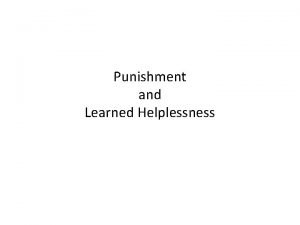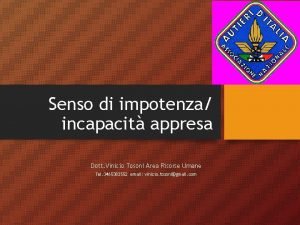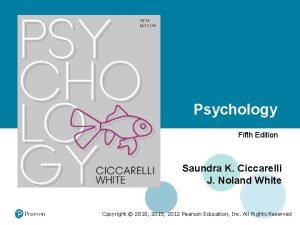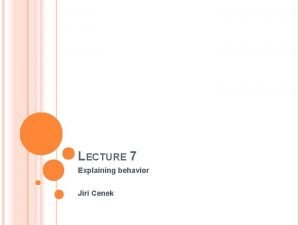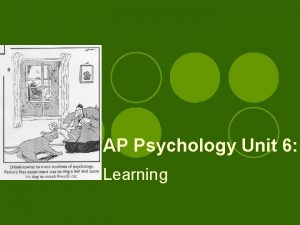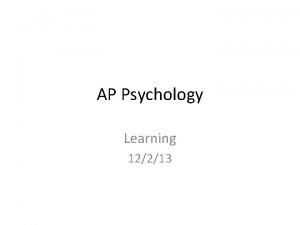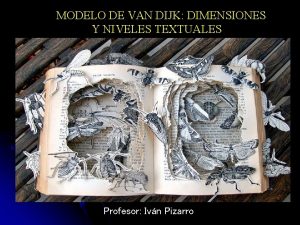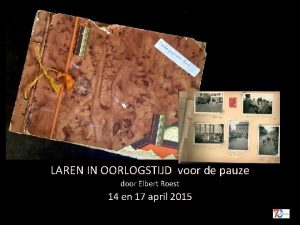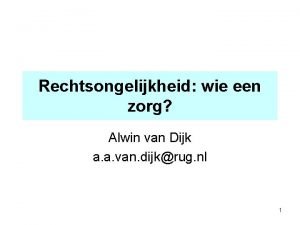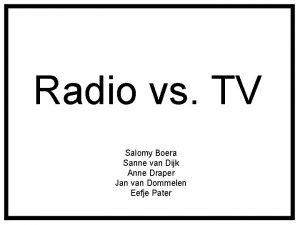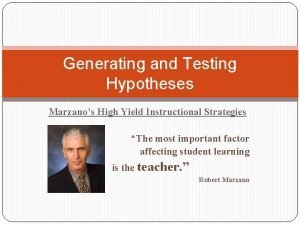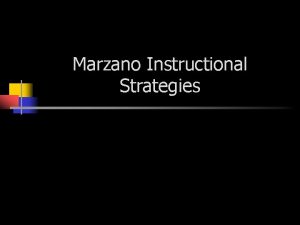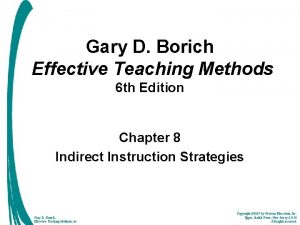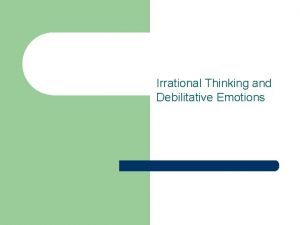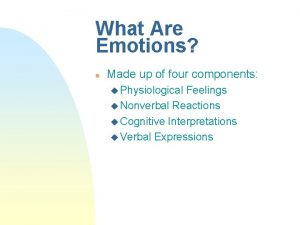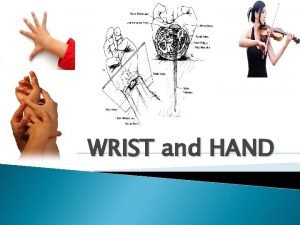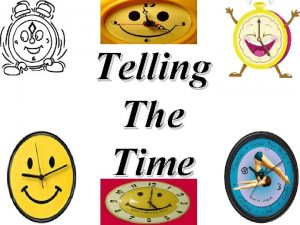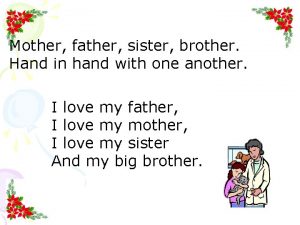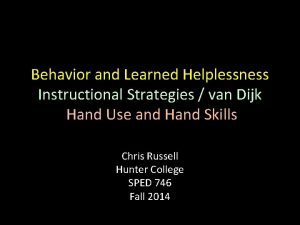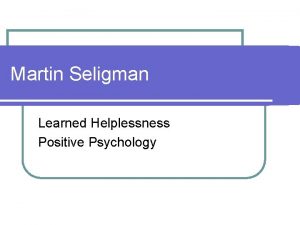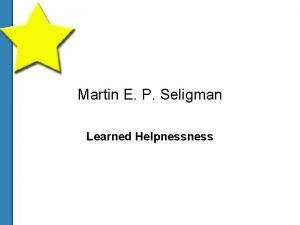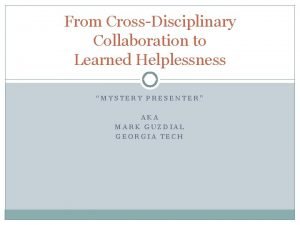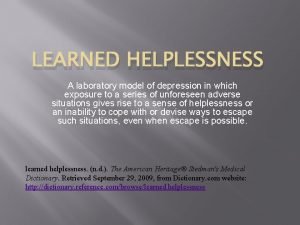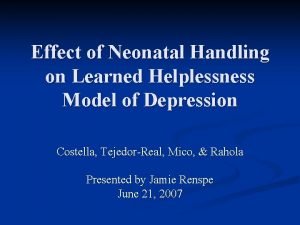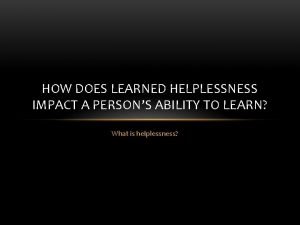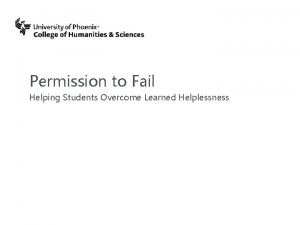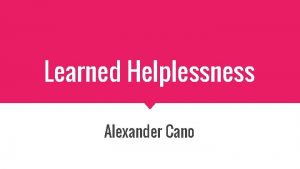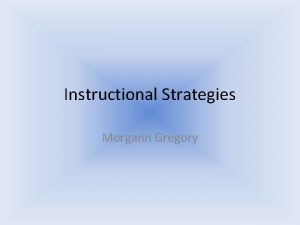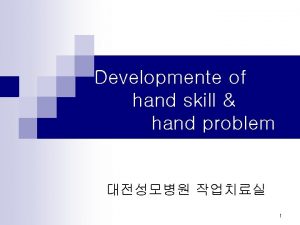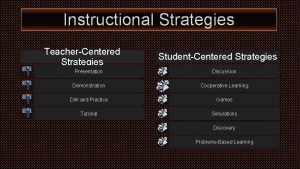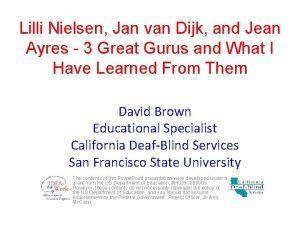Learned Helplessness Instructional Strategies van Dijk Hand Use



























- Slides: 27

Learned Helplessness Instructional Strategies / van Dijk Hand Use and Hand Skills Chris Russell Hunter College SPED 746 Fall 2015

Learned Helplessness • Motivational / Affective / Cognitive • Absence of natural motivators • Reliant on others – Support exploration – Give communication • LOCUS of CONTROL – Internal or External – Stable or Unstable – Global or Specific (domains)

Learned Helplessness • Cyclical System – Increased opportunity to adjustment maximizes gain – Lack of opportunity to adjust minimizes gain (Mithaug) – Disconnect between action and outcome – Multigenerational in a social context • 2 Types – Inborn passivity – Learned Helplessness

Learned Helplessness Risk Factors § Lack of initiation § Lack of participation/persistence (indicator of mastery motivation) § Few if any reinforcers (self stim) § Others to do for (surrogate behavior) § Low expectations, “kindness” or “helping” § Caregivers overgeneralizing their supportive role § § § § Prompt dependence – wait for others to tell what to do Interaction avoidance, refusal to make choices or try new things History of reinforcement for little effort or for no reason High levels of tangible reinforcement Physical manipulation History of failure Limited exposure and response to contingent behavior Depression and self-abuse

Reducing and preventing Learned Helplessness Expectations appropriate to ability § Just right match § Zone of proximal development § A felt difficulty

Reducing and Preventing Learned Helplessness • • § Healthy attachments Predictable environments Appropriate expectations Appropriate forms of communication Routines, response to communicative attempts/actions • Reduce surrogate behavior – ID and retrain • Communicate in preferred and accessible modes • Tasks of interest and control

Reducing and Preventing Learned Helplessness • PCP/PFP • Choices and preferences – create a “master list” of preferences – Multisensory stimulation, sensory feedback • Proper reinforcement of initiations • Reward independent behavior § Complete task analysis § ACTIVE TASKS that provide opportunities for success and communication § Integrate O&M skills § Accurate tracking of progress

Van Dijk Theoretical Construct 14 Instructional Strategies (adapted from Mc. Farland, 1995)

Background and Development • Van Dijk’s work with children: “…became very aware of the unique status of the child who is deprived of hearing and sight from birth. ” • Werner and Kaplan’s (1963) theory of DISTANCING in typical child development of representational and symbolic abilities • Uden’s (1977) concepts of development of language in children who are deaf/HOH • Bowlby, Ainsworth, Bell, and Stayton’s (1973) concepts of development of attachment and socialization

Development of initial attachment and security Resonance phenomenon strategies: • pre-conscious level (reflexive reactions to stimuli, a reverberation of physical, vocal, and/or affective behaviors). • GOAL: Rapport and trust • The teacher follows (joins in) the learners behavior and begins to lay the foundation for turn-taking interactions. Physical proximity • Encourage the learner to shift self-stimulatory behaviors to behaviors that involve other persons and objects. 2/11/2022 10

Development of near and distance senses in relation to the world Movement Strategies: • Co-active movement is an extension of resonance, but the difference is that the learner is more conscious of the "turn-taking" aspect and the person involved in the dialogue (interchange). • The teacher follows the learner's movements in a reciprocating fashion. Also, the learner may follow a teacher initiated movement. • Builds into “chains” through sequencing movements in functional context 2/11/2022 11

Development of near and distance senses in relation to the world Co-active manipulation strategy: • Co-active manipulation involves hand-underhand or hand-over-hand instruction during the learner's daily living routine • Co-active manipulation is gradually lessened (distance is taken) as the learner gains more independence

Development of near and distance senses in relation to the world Representational reference strategies: • essential part of symbol development, often occurs with co-active manipulation • The learner and partner encounter a common thing without actually having a referent (a name) to that "thing"; communication still takes place. • Establishment of shared mode Distancing • Generalizing words, fading reliance on context • Commenting on gestures that refer to a real experience (including BETs)

Development of near and distance senses in relation to the world Imitation instructional strategies: • Higher order of coactive movement strategies • The learner can follow the actions of the teacher, (or peer, parent, etc. ) without any physical support (except in the case where a learner is totally deaf-blind with whom coactive manipulation must be provided as an initial imitative model) • Temporal distance is gradually introduced

Development of near and distance senses in relation to the world (3) Drawing instructional strategies: • Drawing promotes the use of residual vision and allows the learner to have a communicative medium that is clear for the learner and the teacher. • co-actively tracing objects with the learner's finger or with a marker for the development of a conceptual object of reference • Vibrational-sound induced strategies: • Designed to encourage auditory conditioning and auditory attentive behaviors in the context of functional activities as well as natural settings. 15

Development of the ability to structure his/her world Discrimination instructional strategies (i. e. , sorting, comparing, ordering, grouping, and choosing): • Discrimination strategies used to teach the learner to be aware of objects • Level 1 strategies: at presymbolic level, few interactive skills – Teach student to be aware of objects in the environment – Learn that objects have unique characteristics that can be compared, sorted, and chosen within meaningful contexts • Eg during a hygiene routine in the bathroom, presented with a shoe and a hair brush, learning to choose the hairbrush • Level 2 strategies – More practical and complex, eg setting the table, sorting washed clothes 16

Development of the ability to structure his/her world Characterizing strategies: • Assists the learner to build a repertoire of communicative referents. • Teach learner to associate communicative meaning with events and things in the learner's world through natural gesture, associative object , texture, sound, pictures, written, spoken, and or fingerspelled • Important for the development of symbolic language.

Development of the ability to structure his/her world Sequential memory strategies: • The teacher uses schedules /calendars, sequence or memory boxes) and the diary (or memory book) to help the learner understand remember certain time sequences • Develop schedule according to individual child

Development of natural communication systems Conversational communication strategies: • Integrated throughout the learner's program • Teacher must plan the daily activities and the environment to integrate meaningful communication opportunities • clear communicative forms that represent functions so the learner can eventually, connect form & function and generalize its meaning across varying contexts. Anticipatory communication strategies: • founded upon routine – seize the opportunity – For example, when a familiar activity is changed, purposely or coincidentally, the learner has the opportunity to express his/her awareness that something is different 2/11/2022 19

Development of natural communication systems Symbolic communication instructional strategies: • These strategies are the bridge between the learner's use of natural symbols and truly symbolic language. • The teacher uses fading and shaping procedures to refine natural symbols to drawings, written words, to formal signs, and/or to speech. • Use language in functional routines paired with concrete referents

Talking the Language of the Hands • Fraiberg: – Discovery of the hands as very expressive tools for the developing child who is blind: “they often take over the functions that smiling, eye gaze, and facial expressions perform for the sighted child” – Reading the hands (eg mothers) can promote connection, opportunity for turntaking • ATTACHMENT

Hand Use and Tactile Interaction § Hand over hand is a typical reaction by adults in their interactions, social or instructional § When adults do not know how to communicate or are not comfortable interacting with children they become directive (defense mechanism) § Hand over hand, while sometimes necessary for instruction, causes tactile defensiveness, aggression, passivity, and learned helplessness

Adults need to change their attitude/ philosophy and put themselves in an interactive instead of directive mindset

Hand Use and Tactile Interaction § Alternatives § Hand under hand § Mutual tactile exploration § Paired objects § Tactile modeling

Hand Skills § The use of two hands to define space § The reciprocity between the two hands § The speed of the actions, as well as directionality and force § Other important hand skills? 2/11/2022 25

Hand Under Hand § Touch cues eg to replace pointing § Joint attention § Allows a child to know that you share the experience § Does not obstruct the child’s own experience of objects • • Observational experience of modeled hand skills Spatial awareness-- of space between hands Participation (eg coactively in tasks/ADLS etc) Stimulate curiosity, self efficacy, reduce passivity and LH

Teaching Skills that Facilitate Hand Development and Expressiveness • Miles’ 13 strategies from “Talking the Language of the Hands to the Hands”
 For punishment to be maximally effective, it should be
For punishment to be maximally effective, it should be Learned helplessness theory psychology
Learned helplessness theory psychology Learned helplessness psicologia
Learned helplessness psicologia Instinctive drift psychology definition
Instinctive drift psychology definition Learned helplessness psychology
Learned helplessness psychology Learned helplessness
Learned helplessness Latent learning ap psychology
Latent learning ap psychology Learned helplessness ap psychology definition
Learned helplessness ap psychology definition Learned helplessness quiz
Learned helplessness quiz Modelo de van dijk
Modelo de van dijk Craig elbert van dijk
Craig elbert van dijk Van dijk macroestructura
Van dijk macroestructura Pim van dijk
Pim van dijk Alwin van dijk
Alwin van dijk Sanne van dijk
Sanne van dijk Gineke van dijk
Gineke van dijk Handsoft pro
Handsoft pro Marzano 9 instructional strategies
Marzano 9 instructional strategies Marzano's high yield strategies
Marzano's high yield strategies Marzano strategies
Marzano strategies Indirect instruction
Indirect instruction Marzanos instructional strategies
Marzanos instructional strategies Fallacy of helplessness
Fallacy of helplessness What are facilitative emotions
What are facilitative emotions Dijk
Dijk Bunnel littler test
Bunnel littler test Hour hand and minute hand
Hour hand and minute hand Mother father sister brother
Mother father sister brother
